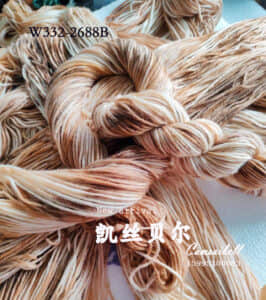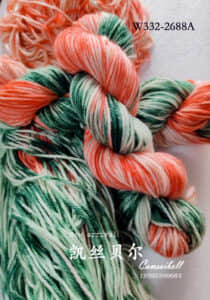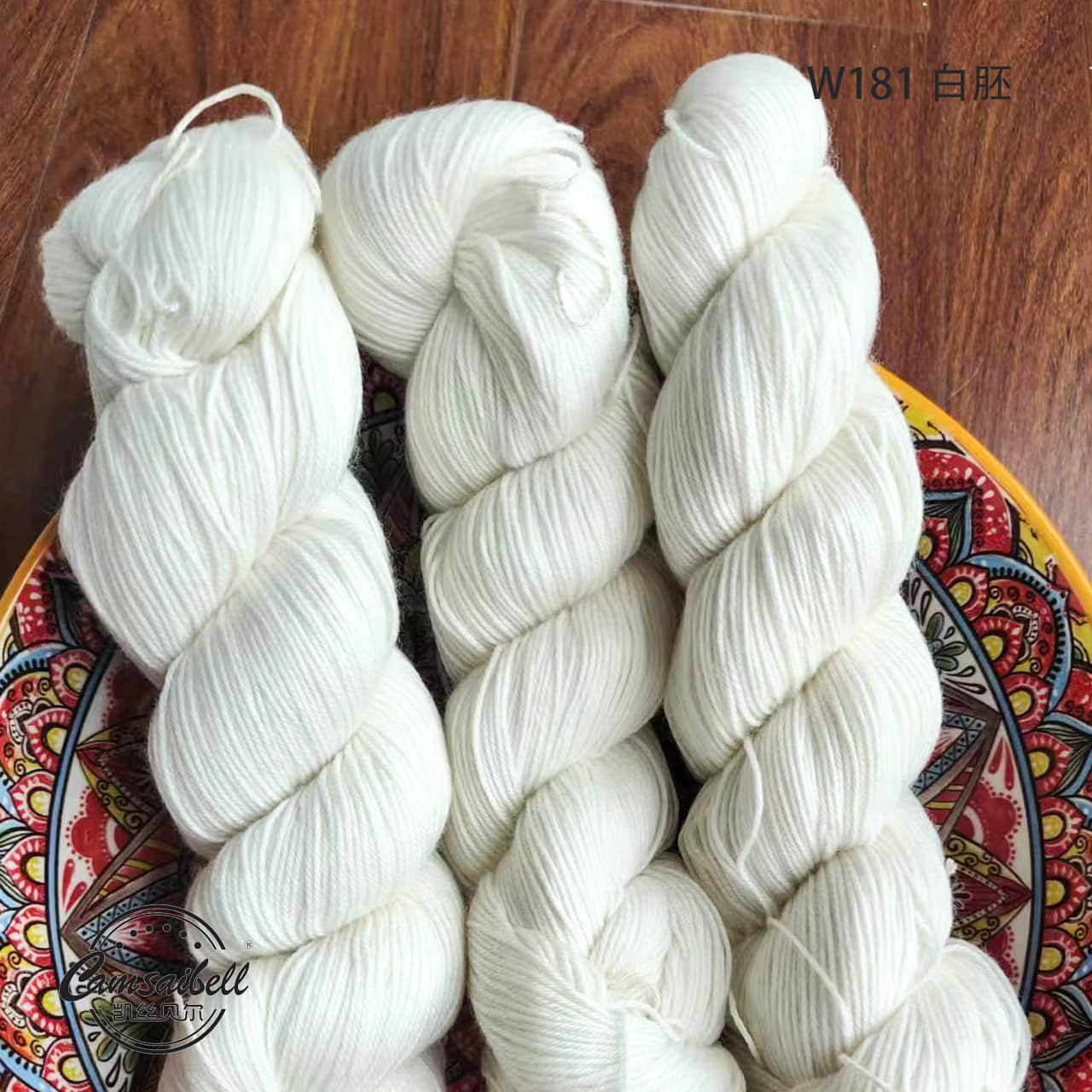In the vibrant landscape of textile innovation, China plant dyed yarn emerges as a beacon of eco-conscious practices, challenging the status quo dominated by synthetic alternatives. This journey delves into the lush tapestry of advantages that this sustainable alternative brings to the forefront, redefining the narrative of the textile industry.

- A Symphony of Natural Hues:
China plant dyed yarn draws its hues from the rich palette of nature itself. Unlike synthetic dyes that often produce uniform and artificial colors, plant-based dyes offer a symphony of natural tones. From the earthy browns derived from walnut shells to the soft blues extracted from the indigo plant, each strand carries the essence of the botanical world.
- Gentle on the Earth:
The process of dyeing with plant-based extracts is inherently gentle on the environment. Synthetic dyes, notorious for their chemical-intensive production, contribute to water pollution and environmental degradation. In contrast, China natural dye yarn embraces a more harmonious approach, utilizing renewable resources and minimizing the ecological footprint.
- Preserving Traditional Craftsmanship:
China plant dyed yarn is intertwined with the preservation of traditional craftsmanship. As artisans delve into age-old dyeing techniques passed down through generations, the industry becomes a custodian of cultural heritage. This not only sustains traditional knowledge but also elevates the authenticity and value of the final product.
- Sustainable Agriculture Practices:
The cultivation of plants for dye extraction aligns with sustainable agriculture practices. Unlike the energy-intensive production of synthetic dyes, which often relies on petrochemicals, plant-based dyes encourage the cultivation of dye-yielding plants. This promotes biodiversity, supports local farmers, and contributes to sustainable land use.
- Human and Eco-Friendly Processing:
The manufacturing process of China plant dyed yarn emphasizes human and eco-friendly practices. Traditional dyeing methods involve minimal chemical interventions, reducing the risk of harm to both workers and the environment. This commitment to a healthier production process resonates with the growing demand for ethical and sustainable fashion.
- Biodegradability and Circular Economy:
Synthetic dyes contribute to the persistence of microplastics in the environment, posing a significant threat to ecosystems. China natural dye yarn, derived from organic sources, is biodegradable. This characteristic aligns with the principles of a circular economy, where products are designed to minimize waste and maximize resource efficiency.
- Unique Textural Qualities:
Beyond its ecological merits, China plant dyed yarn introduces unique textural qualities to textiles. The interaction between natural dyes and fibers often results in nuanced and irregular patterns, adding character to the fabric. This departure from the uniformity of synthetic dyes contributes to the individuality of each piece.
- Consumer Demand for Sustainable Fashion:
As global awareness of environmental issues grows, consumers are increasingly seeking sustainable alternatives. China plant dyed yarn aligns with this shift in consumer preferences, offering a choice that resonates with those who prioritize ethical and environmentally responsible purchasing decisions.
- Support for Local Economies:
The cultivation and extraction of plant-based dyes create opportunities for local economies. Farmers engaged in cultivating dye-yielding plants become integral to the supply chain. This decentralized approach supports rural communities, fostering economic growth and reducing dependency on centralized production hubs.
- Cultural and Aesthetic Appreciation:
China plant dyed yarn reflects a cultural and aesthetic appreciation for the natural world. The variances in color, often influenced by seasonal changes and geographical factors, celebrate the beauty of imperfection. This nuanced aesthetic aligns with a growing appreciation for authenticity in the realm of fashion and design.
Challenges and Future Outlook:
While the merits of China plant dyed yarn are profound, it’s essential to acknowledge the challenges and look toward the future.
- Scale and Accessibility:
Scaling up the production of China natural dye yarn to meet the demands of mass-market fashion remains a challenge. The accessibility of plant-based dyes on a large scale may require innovations in cultivation, extraction, and processing methods.
- Color Consistency:
Achieving color consistency with plant-based dyes can be more challenging compared to synthetic alternatives. Factors like climate, soil conditions, and plant variations can lead to subtle color differences. Addressing this challenge may involve refining extraction techniques and improving dyeing processes.
- Education and Consumer Awareness:
Building consumer awareness and educating the market about the benefits of China plant dyed yarn is crucial. Many consumers are still unfamiliar with the sustainable alternatives available. A concerted effort in marketing and education can bridge this gap and foster a greater appreciation for eco-friendly textiles.
- Collaboration Across Industries:
Successful integration of plant-dyed yarn into mainstream fashion requires collaboration across industries. From farmers cultivating dye-yielding plants to textile manufacturers and fashion designers, a coordinated effort is essential. Establishing supply chain transparency and traceability can build trust among stakeholders.
- Innovation in Dyeing Techniques:
Continued innovation in dyeing techniques is vital for overcoming challenges related to colorfastness and vibrancy. Research and development efforts can focus on enhancing the performance of plant-based dyes, making them more comparable to synthetic alternatives.
- Regulations and Standards:
The establishment of regulations and standards for the production and labeling of plant-dyed textiles can provide clarity to both producers and consumers. This regulatory framework can ensure the authenticity and quality of China plant dyed yarn, fostering a sense of trust in the market.
- Circular Design Principles:
Embracing circular design principles is crucial for the long-term sustainability of plant-dyed yarn. This involves creating textiles that are easily recyclable or biodegradable, contributing to a closed-loop system that minimizes waste.

The Path Forward: Embracing a Sustainable Revolution
China plant dyed yarn represents not just a product but a manifestation of a sustainable revolution within the textile industry. As challenges are addressed and innovations unfold, the future promises a shift toward a more harmonious coexistence between fashion and the environment.
The adoption of China natural dye yarn symbolizes a departure from the environmentally detrimental practices of the past. It heralds a future where the threads of sustainability are intricately woven into the fabric of the fashion industry. In choosing plant-dyed yarn, we embrace not only a textile innovation but a commitment to a regenerative and sustainable tomorrow.
As consumers, industry players, and advocates for a greener planet, we hold the power to shape this narrative. Through informed choices, conscious consumption, and a collective dedication to sustainable practices, we unravel a future where fashion and environmental stewardship coalesce seamlessly. The journey toward a more sustainable textile industry begins with every strand of plant-dyed yarn, weaving a story of hope, responsibility, and a commitment to the well-being of our planet.
Conclusion: Weaving a Sustainable Tomorrow
In the tapestry of textile sustainability, China plant dyed yarn emerges as a thread that intertwines nature, culture, and innovation. Its advantages echo beyond environmental considerations, reaching into the realms of cultural preservation, consumer consciousness, and artisanal craftsmanship.
As the fashion industry pivots toward more sustainable practices, the adoption of China plant dyed yarn represents a meaningful stride. This eco-friendly alternative not only meets the demands of the present but also weaves a path toward a regenerative and harmonious future. With every strand of plant-dyed yarn, we unravel a narrative that celebrates the beauty of nature and the promise of a sustainable tomorrow.





